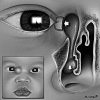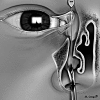Congenital dacryocystocele: diagnosis and treatment
- PMID: 19205594
- PMCID: PMC2689544
Congenital dacryocystocele: diagnosis and treatment
Abstract
Five children were diagnosed with congenital dacryocystocele; in all cases, the cystic lesion was unilateral; age ranged from 7 to 60 days (mean 29 days). The mean ultrasonography diameter of the cyst, at the time of the diagnosis, was 11.51 mm. Topical and systemic antibiotics and massage were prescribed. One patient had no recurrence of the dacryocystocele but 4 showed no improvement with medical treatment; they were submitted to successful probing in the first months of life under general anaesthesia. Nasal endoscopy revealed a nasolacrimal cyst in one patient. True dacryocystocele is relatively rare: ultrasound is a simple, non-invasive method that can reliably distinguish dacryocystocele from other pathological conditions. Several reports have described a variable natural course of these lesions but there are controversial opinions regarding their management. Initially, we treated this congenital anomaly with digital massage, and topical and systemic antibiotics. Probing under general anaesthesia was performed in the event of dacryocystitis or lack of resolution after a short trial period with digital massage. Particular attention was paid to nasal bilateral endoscopy to exclude a nasal obstruction caused by cystic swelling of the nasolacrimal duct. When performed, the probing procedure was successful in all patients.
Sono venuti alla nostra osservazione 5 bambini affetti da dacriocistocele congenito. In tutti la lesione cistica era unilaterale: l’età era compresa tra i 7 ed i 60 gg, età media 29 gg. L’esame ecografico ha evidenziato un diametro medio delle cisti di 11,51 mm. Il trattamento è stato inizialmente di attesa con somministrazione di antibiotici topici e sistemici associati a massaggio. In una bambina questa terapia ha portato alla completa risoluzione dei sintomi nell’arco di 5-6 gg. Quattro, non rispondendo alla terapia medica, sono stati sottoposti a sondaggio delle vie lacrimali, in anestesia generale, con controllo endoscopico della cavità nasale che ha mostrato in un paziente la presenza di una cisti nasolacrimale che è stata marsupializzata. Il dacriocistocele congenito è un’anomalia non comune delle vie lacrimali. L’ecografia permette una corretta e rapida diagnosi differenziale. In letteratura esistono alcuni articoli a riguardo con controversie sul tipo di trattamento da instaurare. Noi abbiamo preferito un iniziale trattamento attendistico con terapia antibiotica associata a massaggio. Il sondaggio delle vie lacrimali associato a controllo endoscopico nasale bilaterale è stato riservato ai bambini che non rispondevano a tale terapia dopo alcuni giorni di controllo o in caso di dacriocistite. La terapia chirurgica ha riportato una completa guarigione in tutti questi pazienti.
Figures





References
-
- Olver J. Pediatric lacrimal surgery In: Olver J, ed. Colour atlas of lacrimal surgery. Oxford: Butterworth Heinemann; 2002. p. 70-89.
-
- Shashy RG, Durairaj V, Holmes JM, Hohberger GG, Thompson DM, Kasperbauer JL. Congenital dacryocystocele associated with intranasal cysts: diagnosis and management. Laryngoscope 2003;113:37-40. - PubMed
-
- Grin TR, Mertz JS, Stass-Isern M. Congenital nasolacrimal duct cysts in dacryocystocele. Ophthalmol 1991;98:1238-42. - PubMed
-
- Mansour AM, Cheng KP, Mumma JV, Stager DR, Harris GJ, Patrinely JR, et al. Congenital dacryocele. A collaborative review. Ophthalmol 1991;98:1744-51. - PubMed
-
- Schlenck B, Unsinn K, Geley T, Schon A, Gassner I, Sonographic diagnosis of congenital dacryocystocele. Ultraschall Med 2002;23:181-4. - PubMed
Publication types
MeSH terms
Substances
LinkOut - more resources
Full Text Sources
Medical
